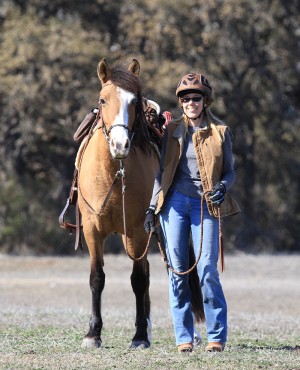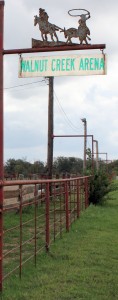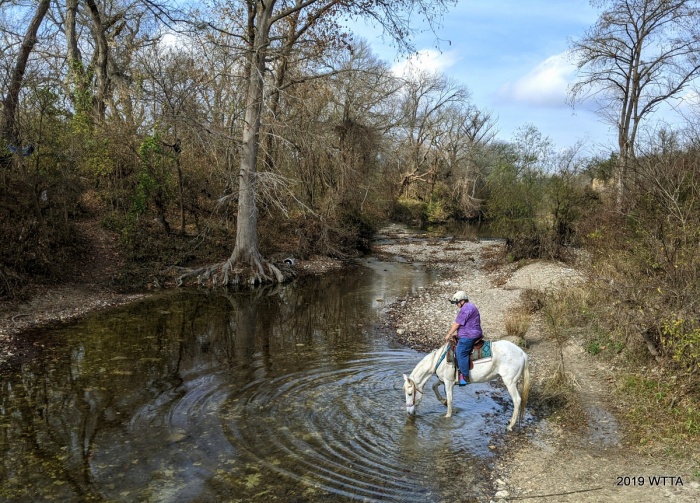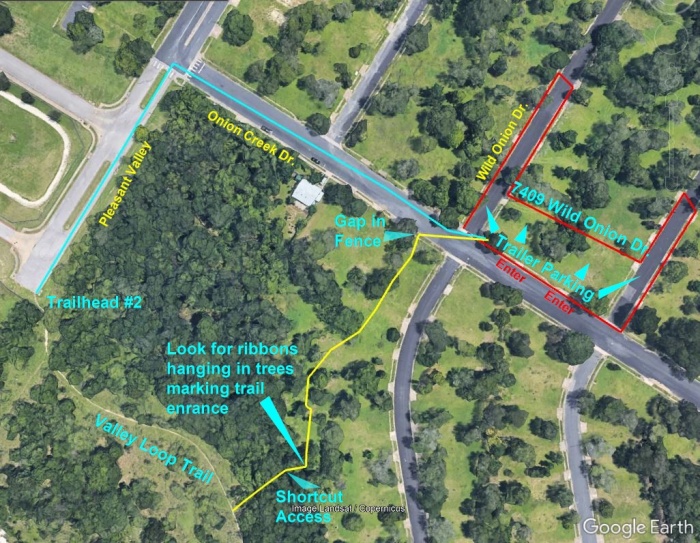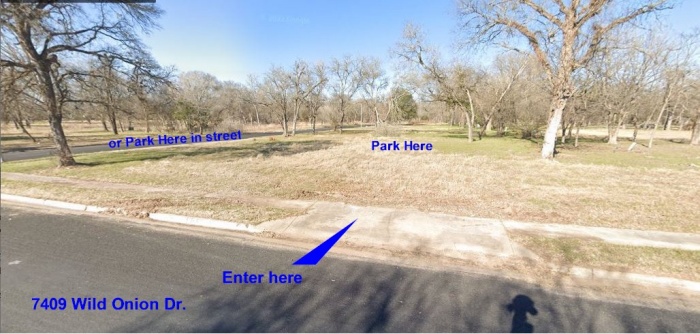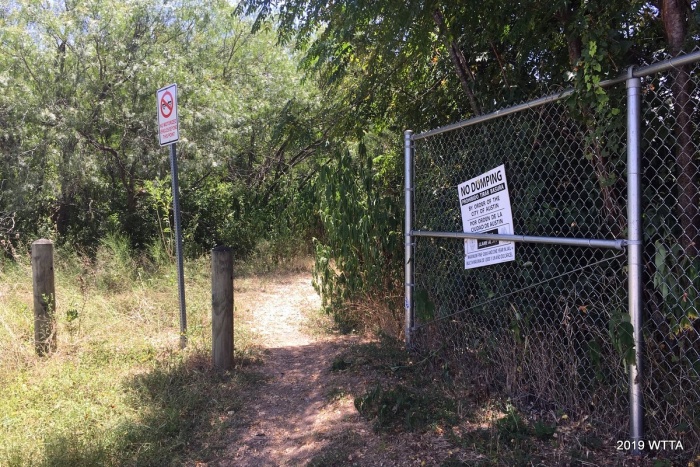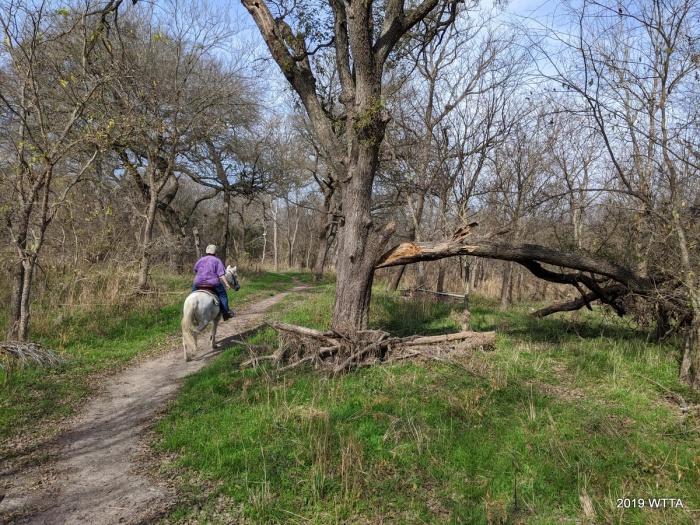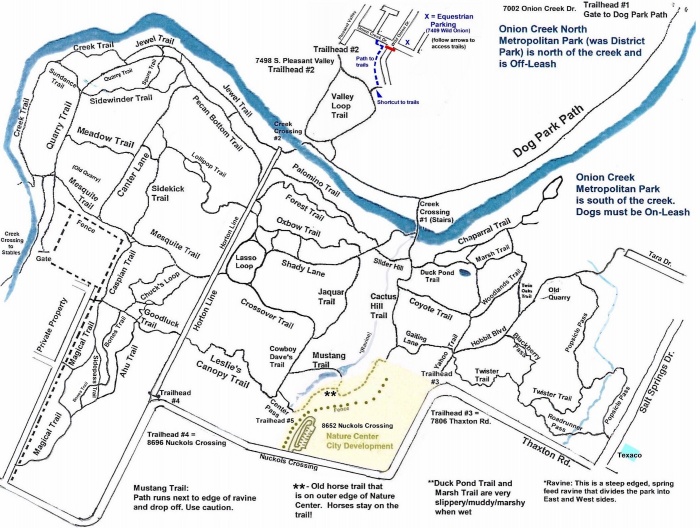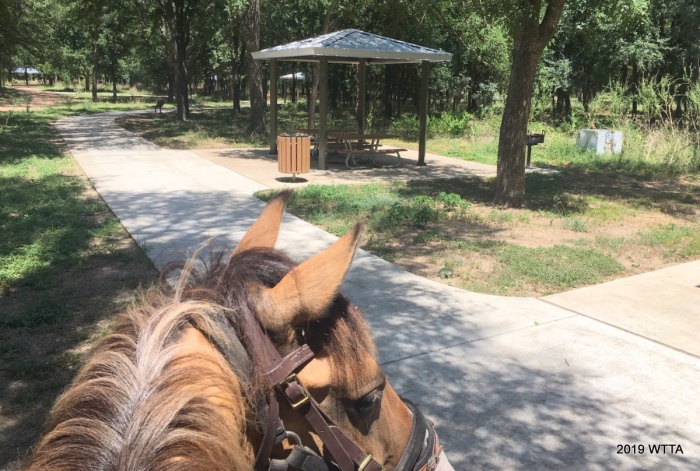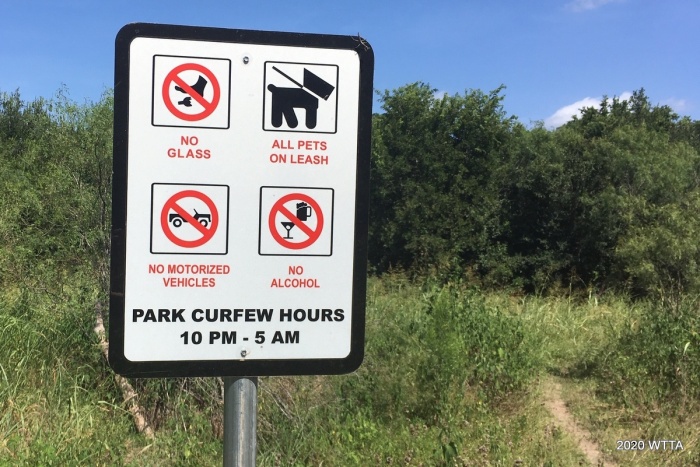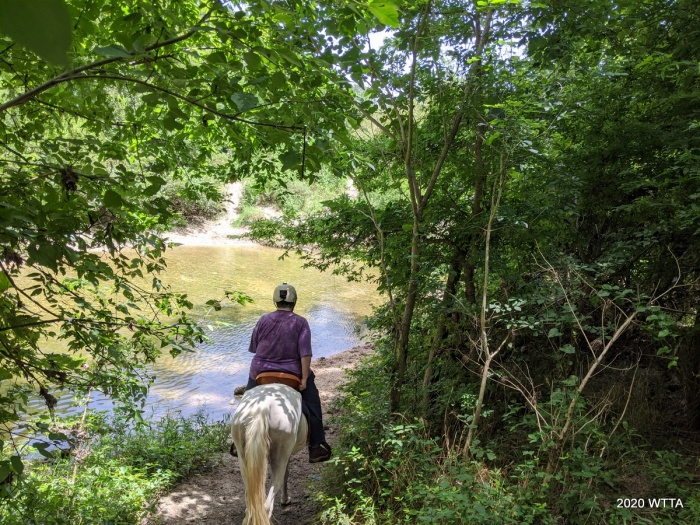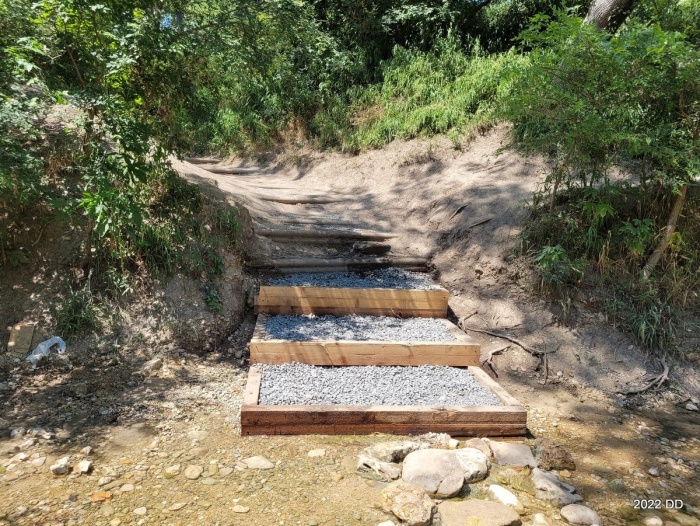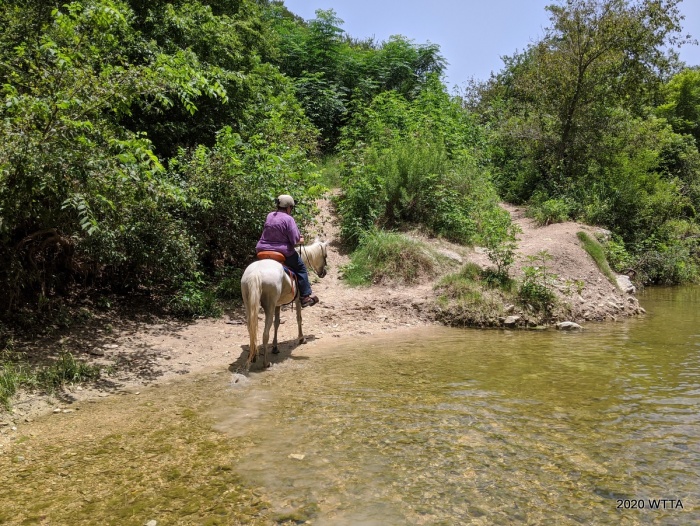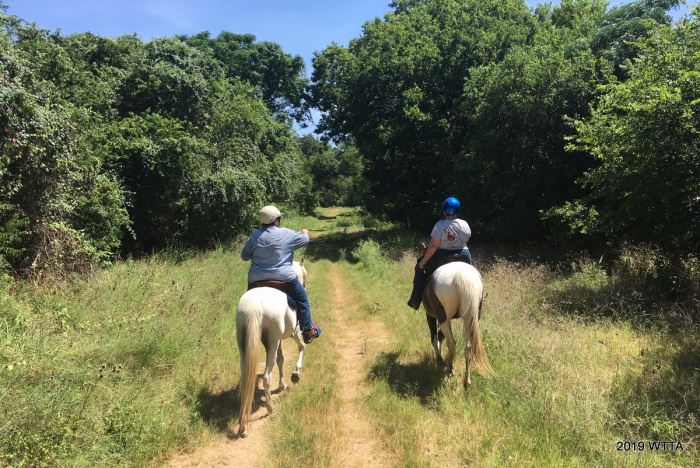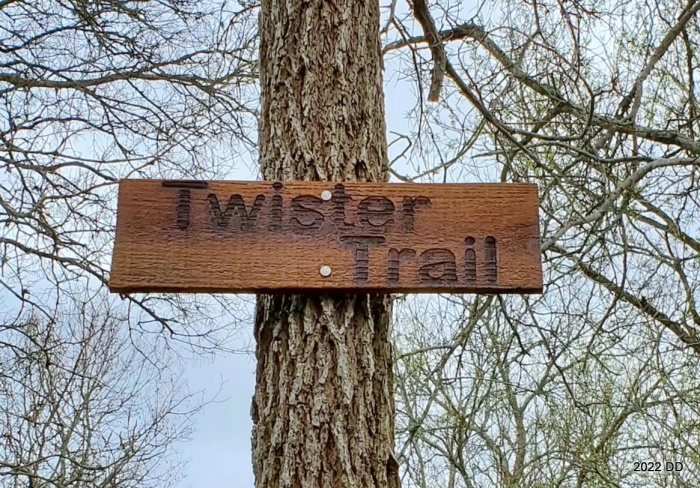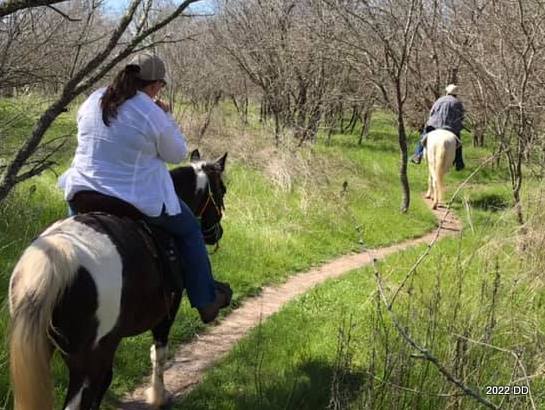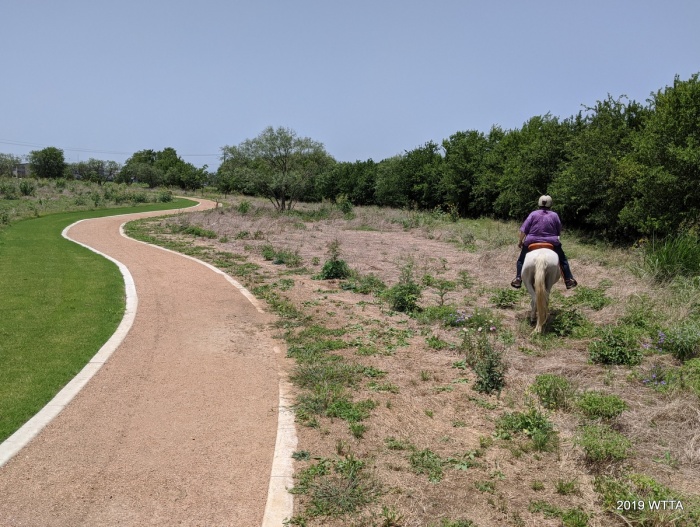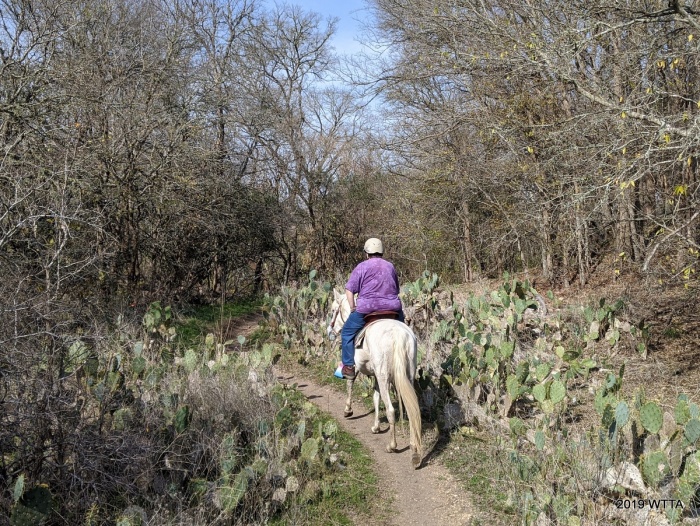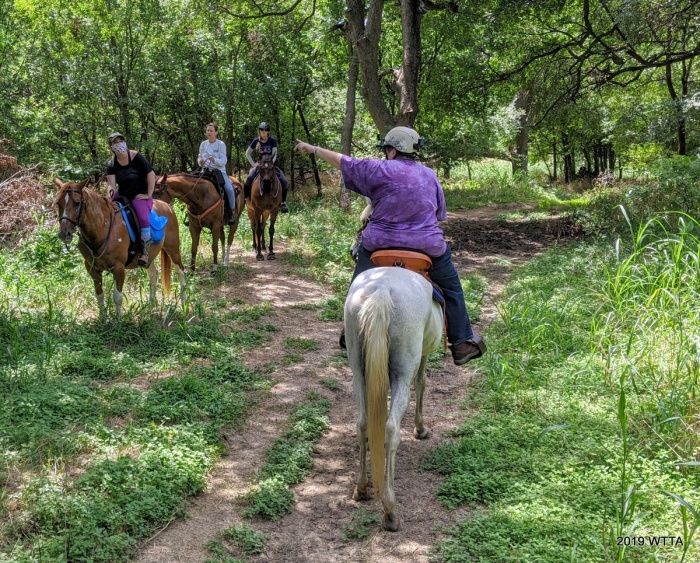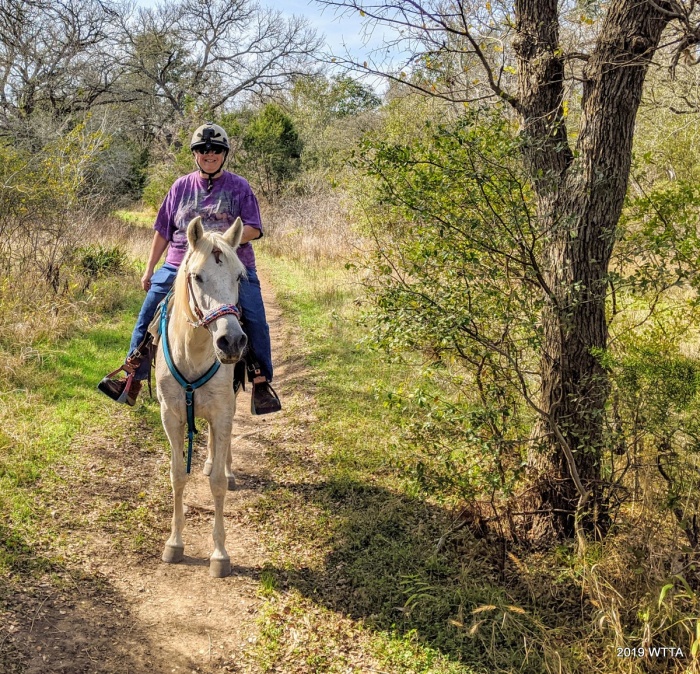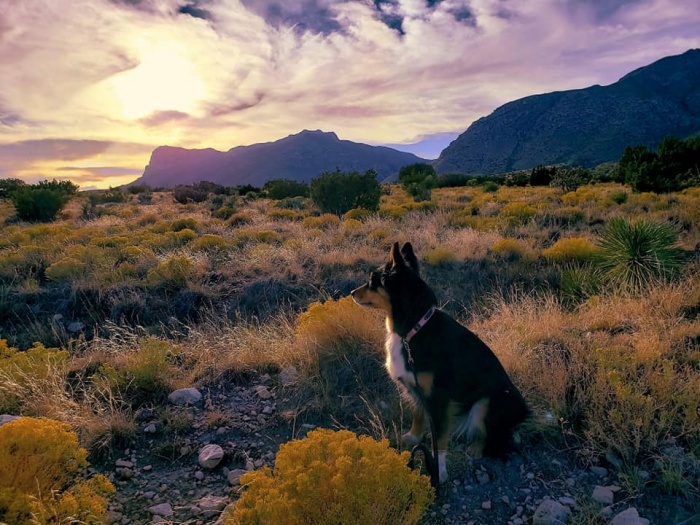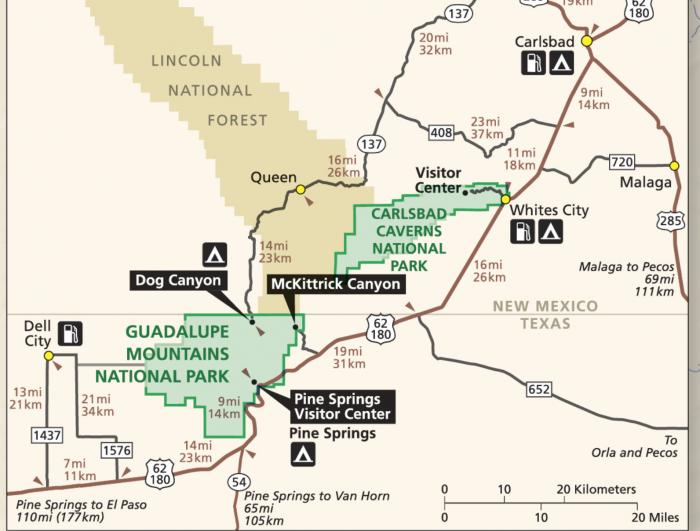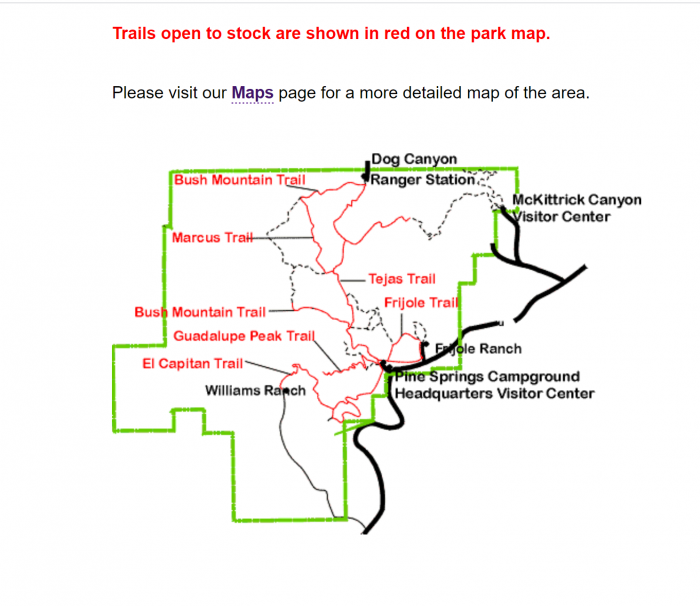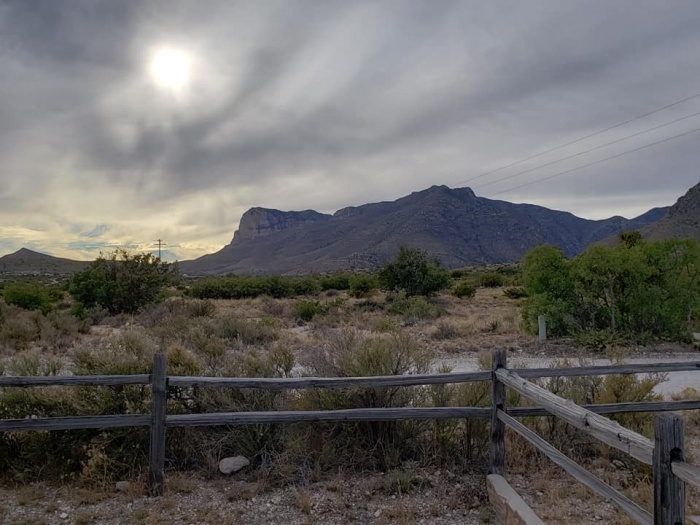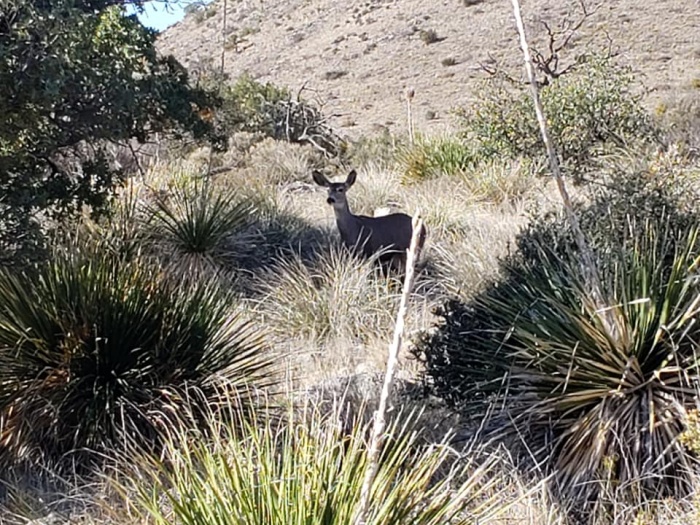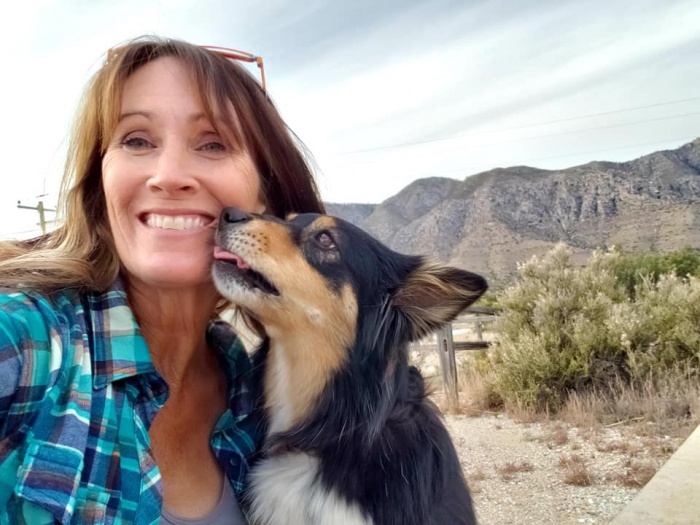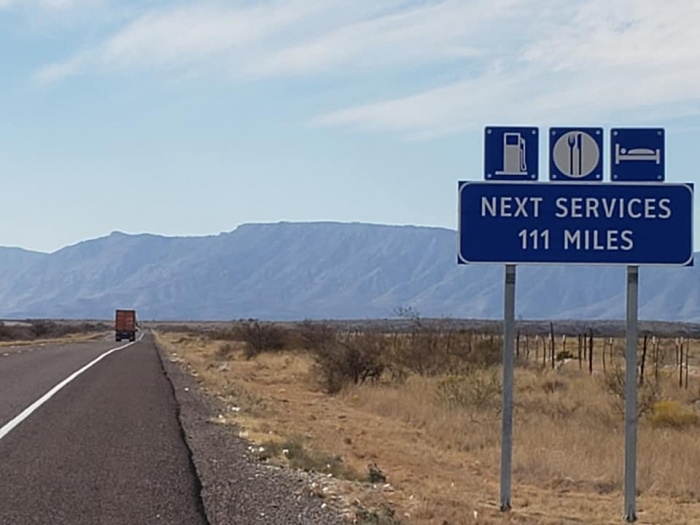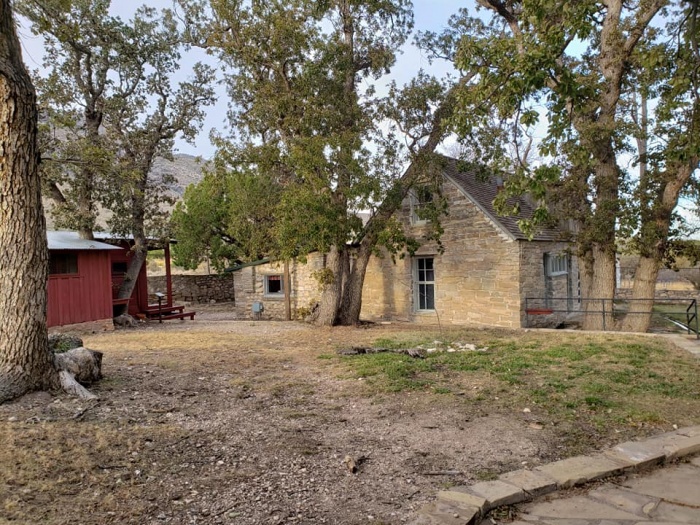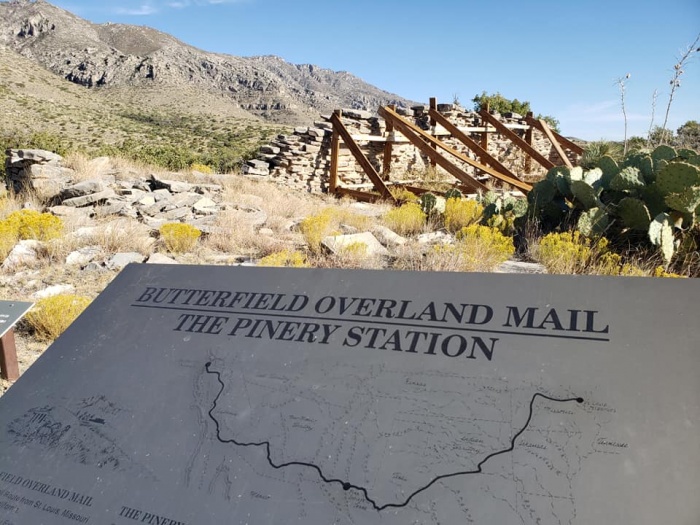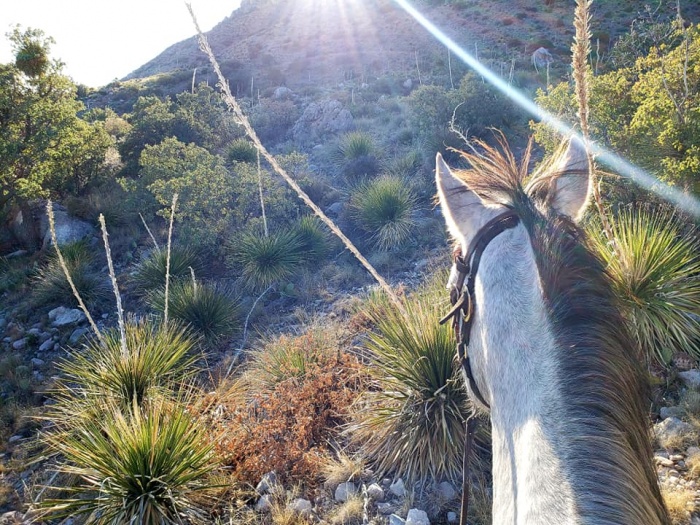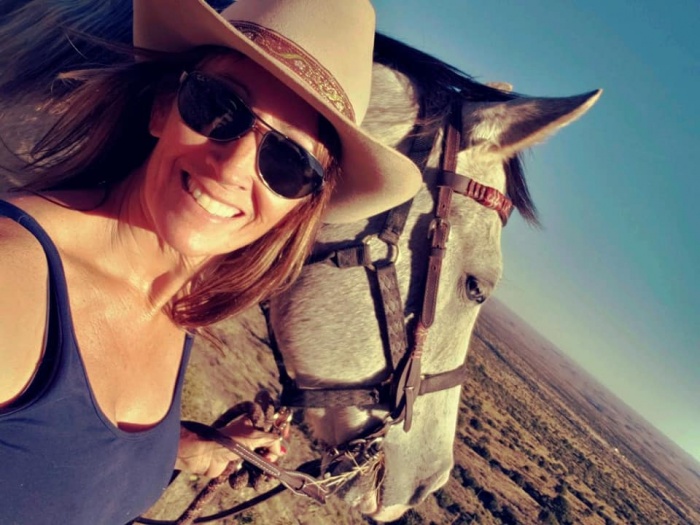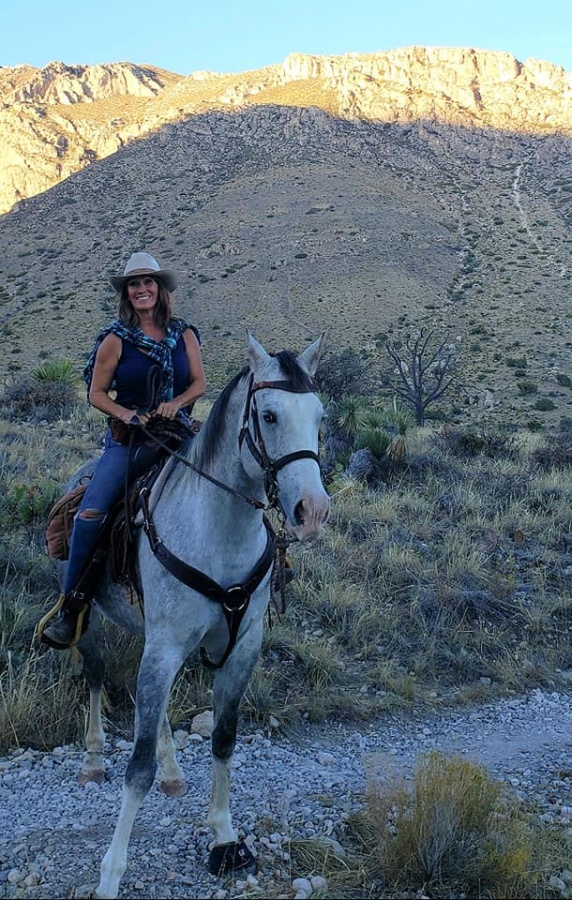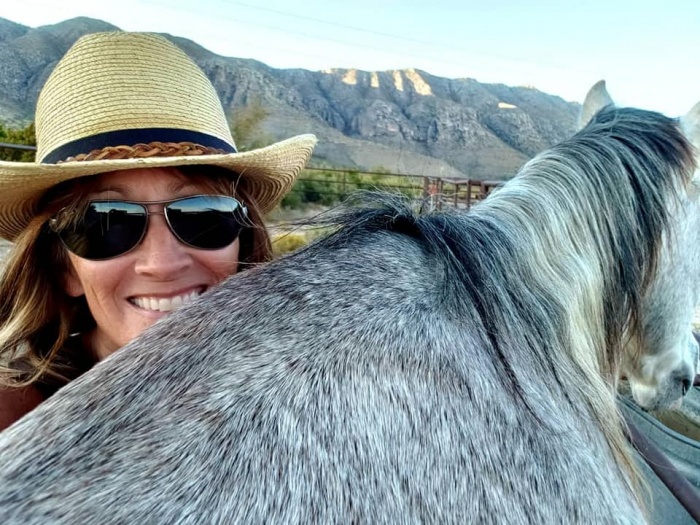Originally published March 30, 2019 — recently updated September 07, 2021
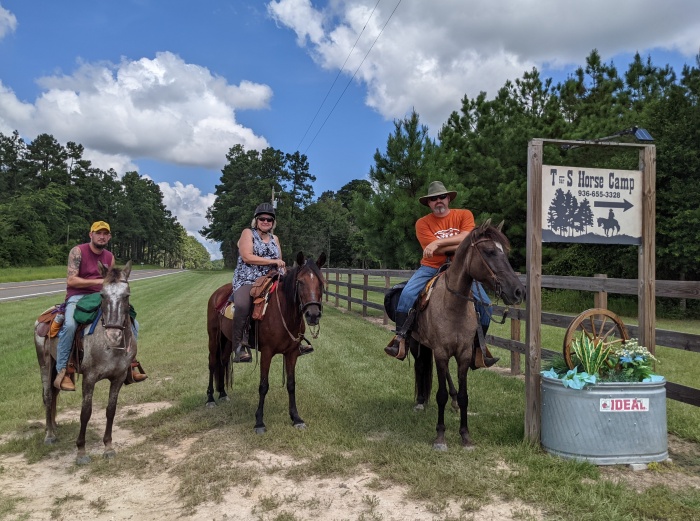
N.E.T.A.S.A (Northeast Texas and Surrounding Area), an American Indian Horse Registry trail riding group, enjoyed T Bar S for at least their 3rd visit on Aug. 29, 2021. Left to right, Zack on Dragon, Patti on Dakota, and Curtis on Rain Man.
Ride beneath East Texas Woodlands deep in the shade of Davy Crockett National Forest. Discover the Piney Creek Horse Trail system, over 50 miles of sandy, gently rolling, well developed horse trails between Crockett and Lufkin. If you want to horse around in comfort, skip roughing it for a change and stay at T Bar S… for both you and your horse’s pleasure.
Location:
T bar S Horse Camp in the Davy Crockett National Forest
6387 FM2781
Kennard, TX 75847

Directions: from Huntsville, travel on TX-19 approximately 20 miles to Trinity. In Trinity turn RIGHT on TX-94 (the 2nd traffic signal) towards Groveton. Travel 16 miles and TX-94 ends/merges with Hwy 287, turn LEFT towards Crockett. Go approximately 8 miles to Pennington and turn RIGHT on FM2781, there is a Spitfire Grill/Gas Station at the intersection. In Pennington make the RIGHT (just past the Church) and then a LEFT (just past Avery’s Welding & Feed) to stay on FM2781 towards Kennard. T bar S is then 6 miles ahead, just past Baker Springs, on the RIGHT.
or
From Crockett or Nacogdoches, travel on TX-7 to Kennard, turn SOUTH at the flashing yellow light which is FM2781. Go approximately 6 miles and T bar S is on the LEFT.
If you accidentally pass T bar S, you can continue on to either Kennard or Pennington to get turned back around.
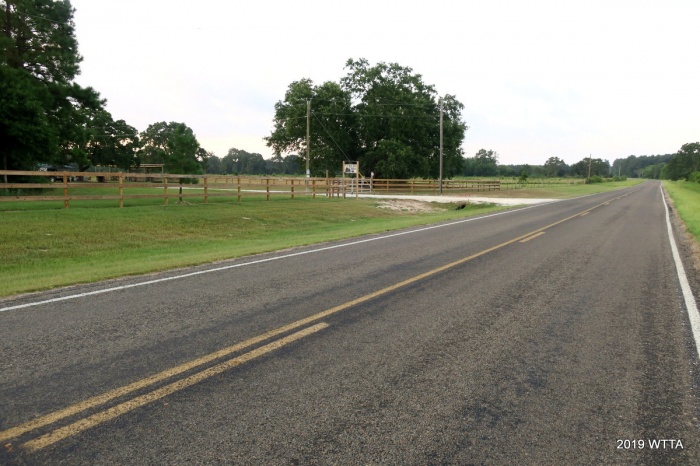
T Bar S is easy to find and right off FM 2781.
Contact:
Tom & Stephanie Hanslik (owners)
Tbarshorsecamp@yahoo.com
(936) 655-3328 office
(832) 928-9584 cell / text
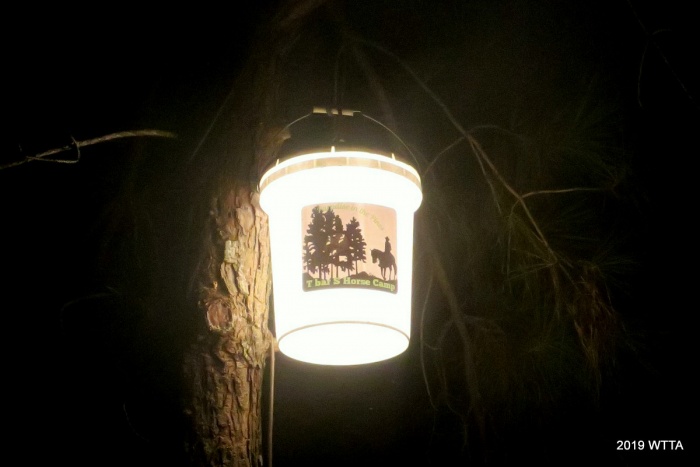
Creative bucket lanterns with the T Bar S logo can be turned on at your campsite.
T Bar S Horse Camp Website: https://tbarshorsecamp.com This is a great website, user friendly and very informative with a facility map, pictures and details about each campsite, park/trail maps and lastly you can make reservations and a deposit via this website.
T Bar S Facebook Group
Hours: Open daily from 8am to 8pm
Overnight camping:
Equestrian overnight camping is allowed, with parking space available for day riders as well.
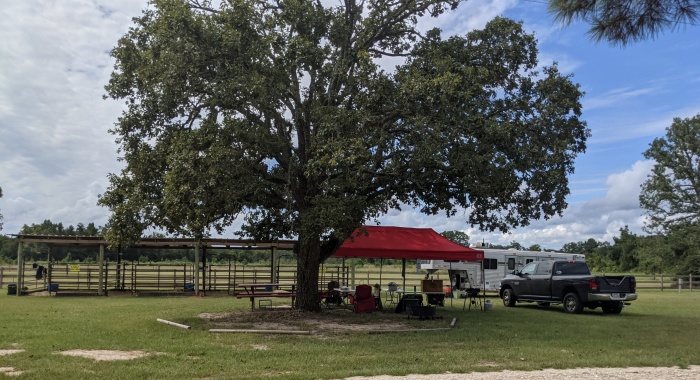
Campsite #2 has four covered pens and a lovely Oak tree for shade.
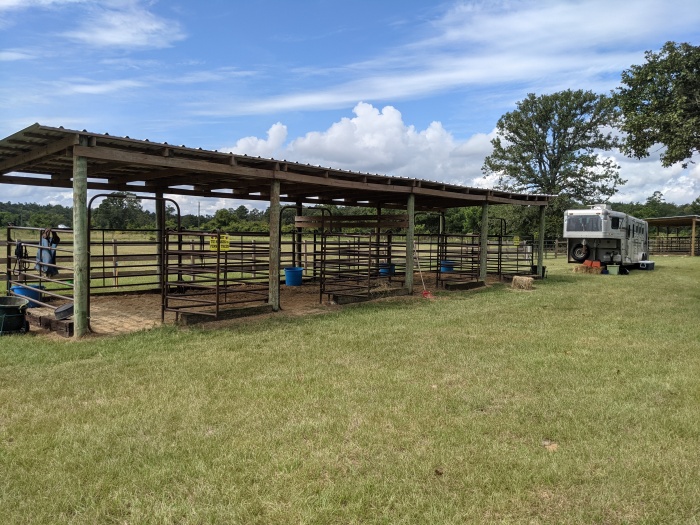
Pens for campsite #2 & #3.
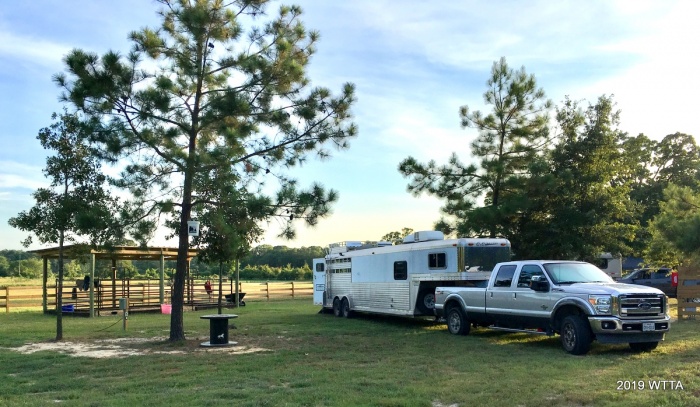
Campsite #4 (picture from 2019) unfortunately has lost a few trees due to the 2021 freeze, however the pens are covered.
Facilities:
- Enclosed air conditioned pavilion with a front patio that has chairs, a barbeque grill and a freezer full of of ice bags for purchase
- Restrooms and showers with AC and vents
- 16 sites with 30 amp and two 50 amp electric and water hookups – see T Bar S website, as details about each campsite are described well with pictures of each site.
- Two horse pens per site; several of the pens are covered. Horse pens are 12×12’ Priefert panels; most pens can be opened to 12×24 for those camping with one horse.
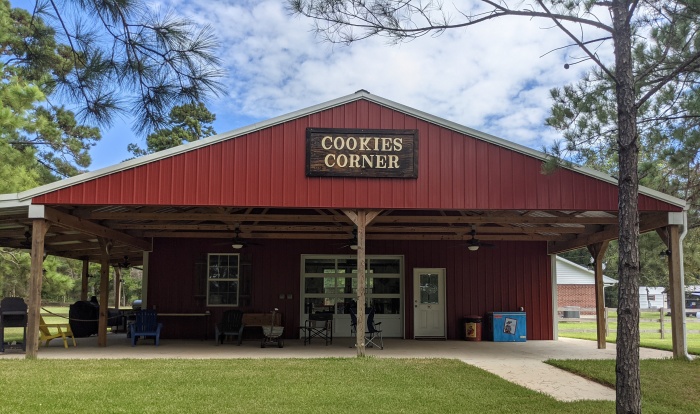
Cookies Corner air conditioned pavilion with patio and large garage type doors that can be opened up when the weather is nice. Oh and did I say there is a blue freezer full of bags of ice you can buy! No more running into town to buy ice – cool.
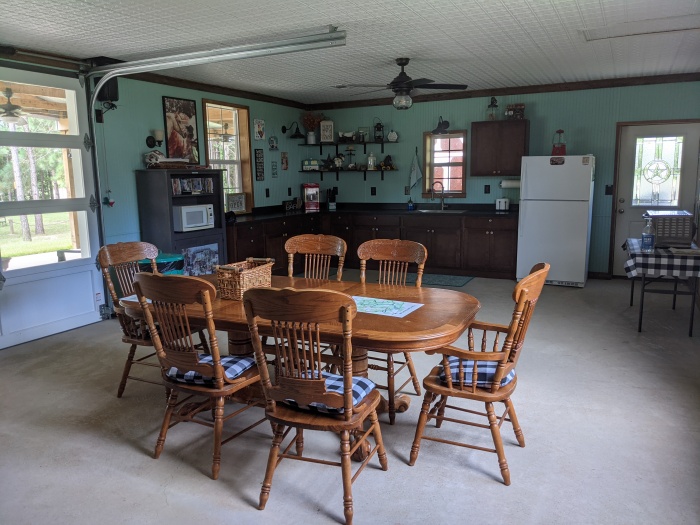
Inside Cookies Corner. We enjoyed playing dominos at this table.
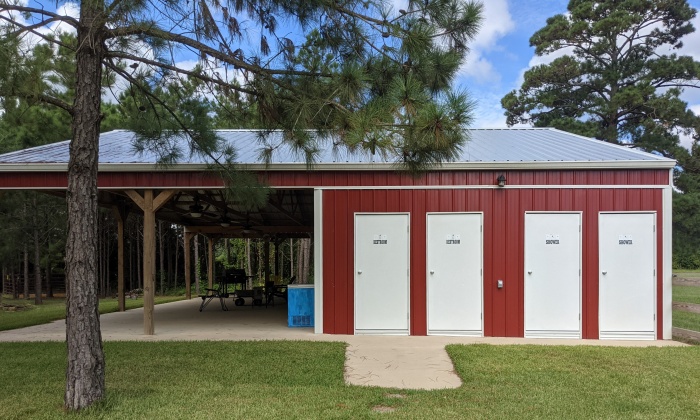
Two bathrooms and two showers on the side of Cookies Corner.
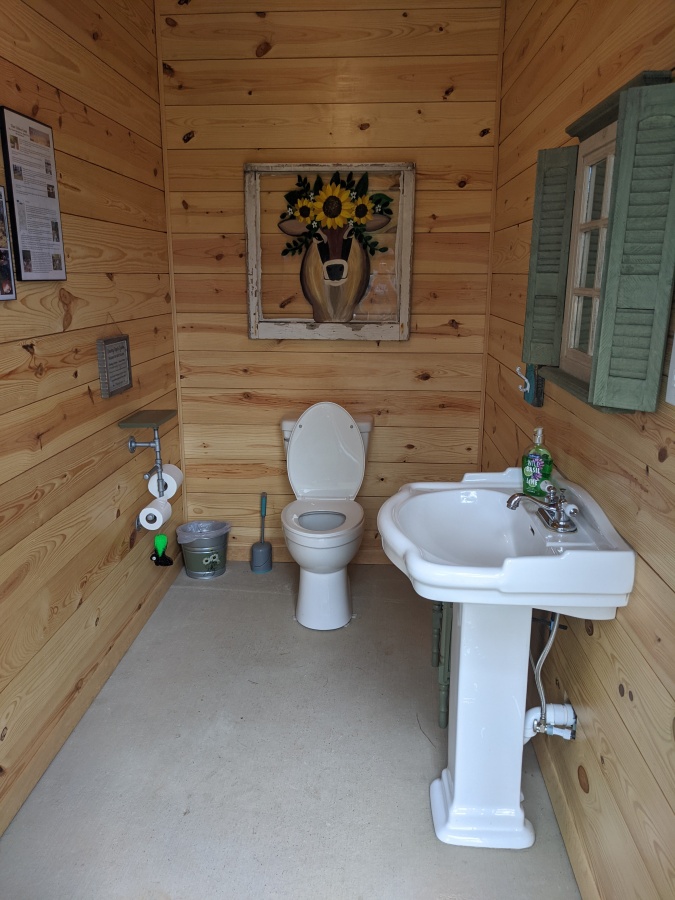
One of two bathrooms.
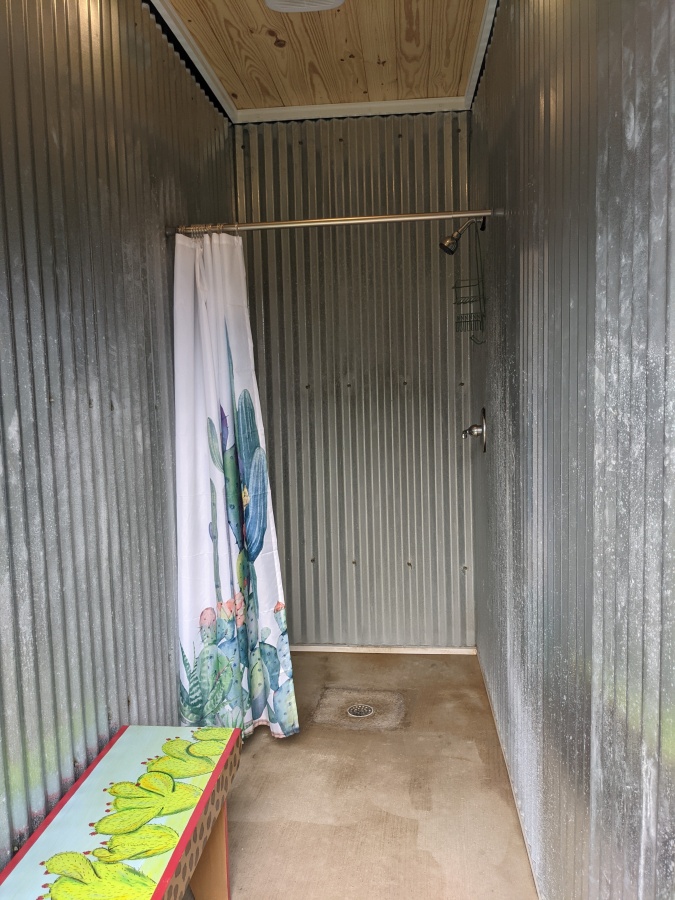
One of two showers.
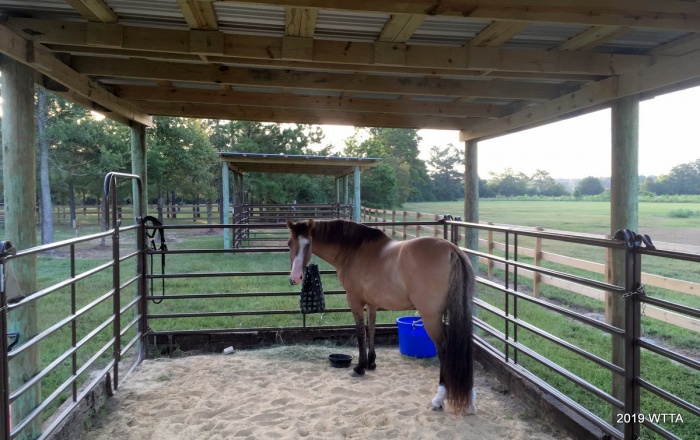
Angel enjoyed her spacious shady suite at T Bar S.
Rates:
Camp for $35/night with 2 pens included in that price, reservations required. Day Riders are welcome at $10 per trailer. Includes secured parking and access to potable water & facilities. Contact camp in advance. There is no fee to ride the trails.
Policies: listed on website.
- Proof of Negative Coggins Required.
- Check-in time is 1pm, check-out time is 12 noon. For later departure check with owners if site is reserved by anyone else. If so, can move to day rider spot or another site if want to ride before heading home.
- No Stallions.
- Dogs welcome but MUST be kept on a leash. It is a working farm with cats, chickens, and ducks.
- Do not tie horses to pens or trees, tie to side of trailer only please.
- Horse pens must be cleaned of all manure and hay upon departure.
- Shavings are permitted.
- Campfires allowed in above-ground rings or community fire ring only.
- No discharging of any waste or gray water.
- Quiet hours begin at 10pm.
- Maximum 4 persons per site
- Maximum 2 horses per site. If more than 2 horses please contact owners, additional pens (if available) are $10/horse per night.
Manure Management:
A few rakes and muck buckets with carts are provided. Please put manure in the spreader. Manure is to be cleaned out of the pens and campsites and then deposited in the manure spreader, there are limited muck buckets so if camp is busy be sure to bring your own muck bucket and manure fork to make the job easier. This is a very clean well maintained facility, thank you in advance for helping to keep it that way.
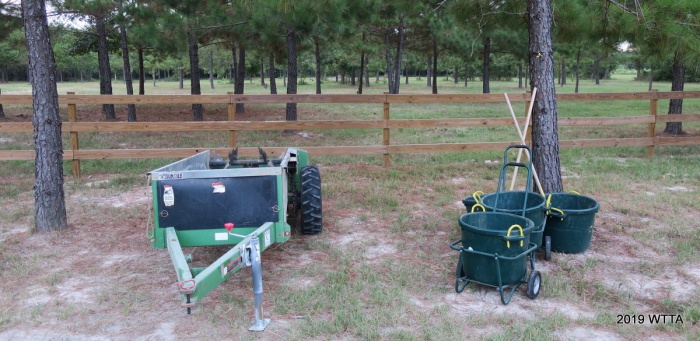
A few muck buckets, carts and rakes are provided. Manure goes in the spreader please.
Dogs: Are allowed but must remain on leash. Owners have two very friendly dogs who do roam the facility freely and like to greet the guests.
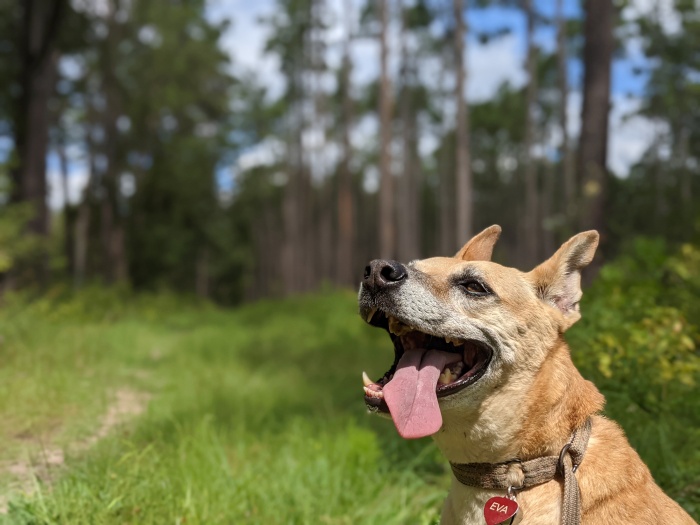
My pup Eva came along and we did a little hiking in the pines, which you can see she loved! Aug. 2021.
Phone Service: AT&T is fairly good (mine did not work inside my trailer but did work outside of my trailer). Straight Talk is said to work well also; while other phone services don’t work as well in this area.
Hunting: Hunting is allowed in the forest, so it is best avoided starting on the first Saturday in November through the end of gun/deer season (approximately mid January). The forest is commonly too wet to ride in these months anyway. Riding the trails from T Bar S during hunting season will be closed, but the T Bar S facility will still remain open and is a great rest stop/lay over for any equine travelers. October is bow season and you may still ride the trails during this time but be sure to wear orange.
Controlled Burns: The U.S. Forest Service conducts controlled burns in the National Forests and Grasslands in Texas from early spring to summer. Check their website ( https://www.fs.usda.gov/detail/texas/home/?cid=STELPRDB5355005 ) and with T Bar S owners, Stephanie or Tom, for information about any possible burns/fires.
Logging: It is always possible there could be some harvesting/logging going on of the pine trees but I hear the loggers are very courteous to the trail users.
Trail Users: Horse/mule riders, hikers, and hunters. No motorized vehicles allowed.
Mileage: Over 50 miles of trail.
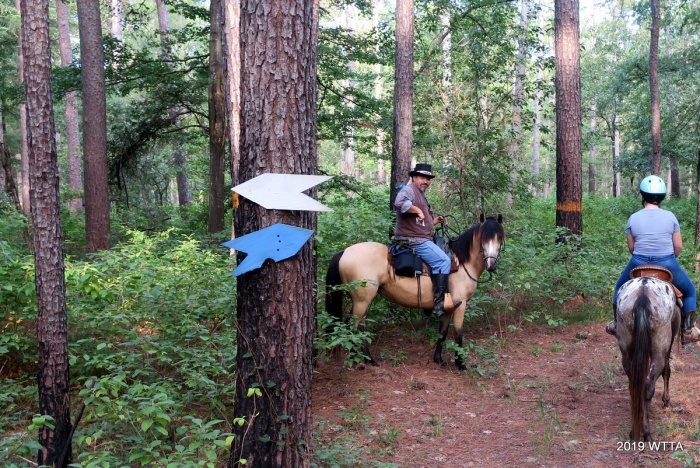
There are some sections of Piney Horse Trail system where the different trail loops merge, such as here with the White and Blue trails intersecting. Curtis on his buckskin Wonder Women, aka Diana, is about the check the map. Which way do we go now?
Maps and trail markers: Maps are online, printed out, and cloth maps on a bandana can be bought at T Bar S for $5. Trails are color coded and well marked.
T-S Piney Creek Horse Trails May2021
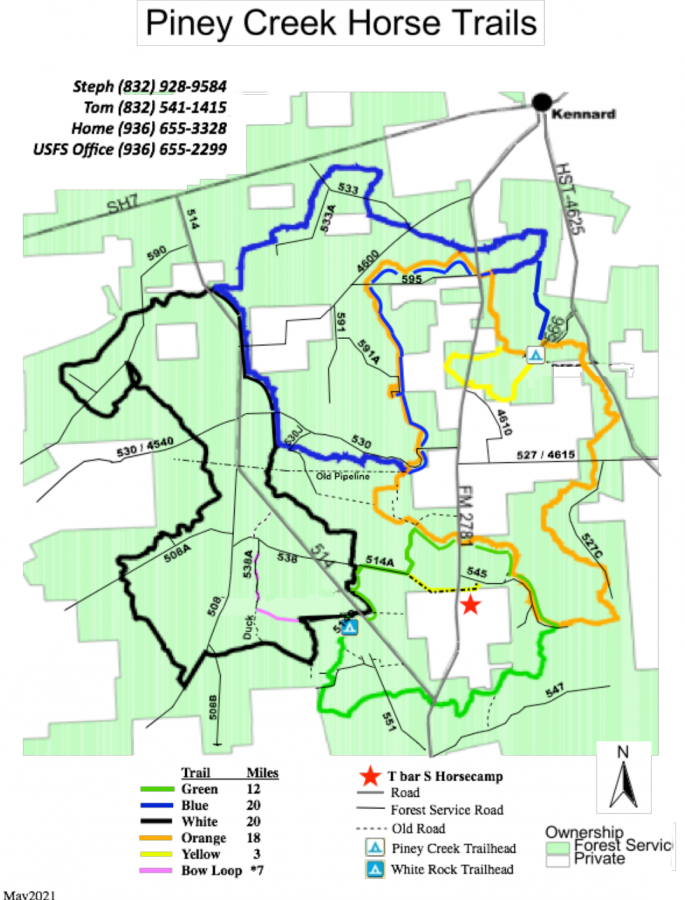
Description:
T Bar S opened in 2019 and has direct access to the 50+ miles of marked and mapped trails in the Davy Crockett National Forest. Owners, Tom and Stephanie Hanslik, have worked hard adding many additions to this awesome facility to include many nice decorative touches. Tom and Stephanie check in on their guests and make sure to keep an eye out for everyone’s safety. It is a good feeling knowing if you don’t come back from trail riding, they will be looking for you and calling the ranger. Tom and Stephanie are helpful and friendly. I would feel very safe camping here solo. Their newest addition to T Bar S is an air conditioned pavilion named Cookies Corner with bathrooms & showers attached to the side. Inside Cookies Corner is a large table and chairs, which was great for playing dominoes. The horse pens are very nice with well secured Priefert panels, soft sand, and several are covered. I really like if you have just one horse, most of the double pens can be opened up to make one large pen. There are two areas where multiple pens are grouped together, a water spigot and hose is supplied for those. But be sure and bring your own water hose for your campsite. Camp and horse pens are very shady, pens that would otherwise be in full sun are covered. Some of the sites are pull-through. Camp is located right off a paved farm-to-market road, very easy to find and no rough dirt or gravel roads to negotiate with your trailer. There is no septic service. There is a dumpster for your trash.
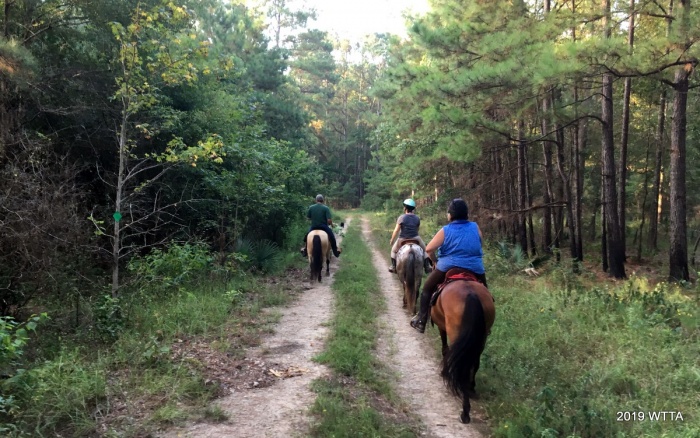
There are several two track forest service roads to ride on.
Trail Access from T Bar S is practically right in the front yard of Tom and Stephanie’s home. Just head out the front entrance gate and turn right or head out the side corner gate to the north of the campsite, cross over the yard and you can head left across FM 2781 or through the trail entrance and to the right. Trails from the camping area to Davy Crockett are yellow and black.

T Bar S gate for trail access, located on the north corner of the camp grounds. A chain latch on top of the post makes it easy to open/close via horseback. Ride straight ahead to the trees and then go right or left across FM 2781 to access the trails.
The Trails:
The Piney Creek Horse Trail system meanders approximately 53 miles through the East Texas piney woods in Davy Crockett National Forest.
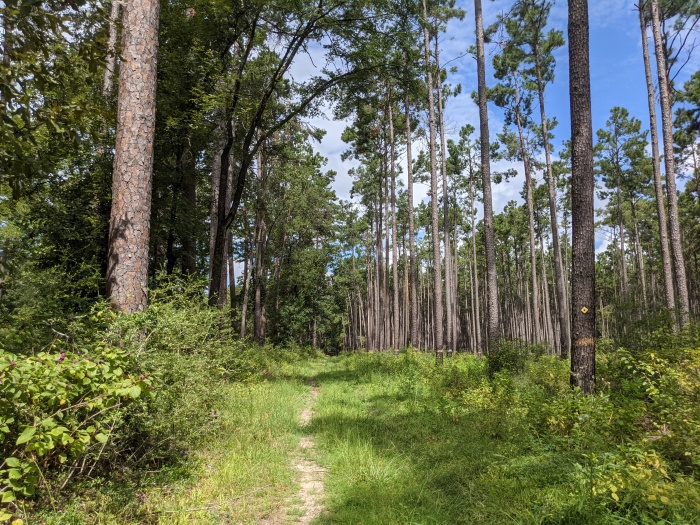
Beautiful evergreen towering pines overhead at Davy Crockett National Forest. Sept 2021.
The mostly barefoot friendly trails are primitive. Paths are cleared through the forest which follows Forest Service roads, tram roads, pipeline right-of-ways, game trails, and in some places it was established by clearing brush and trees through the forest. Primarily, it is on National Forest land, but there are crossings on private property and along public road right-of-ways. In general, the route is well cleared.
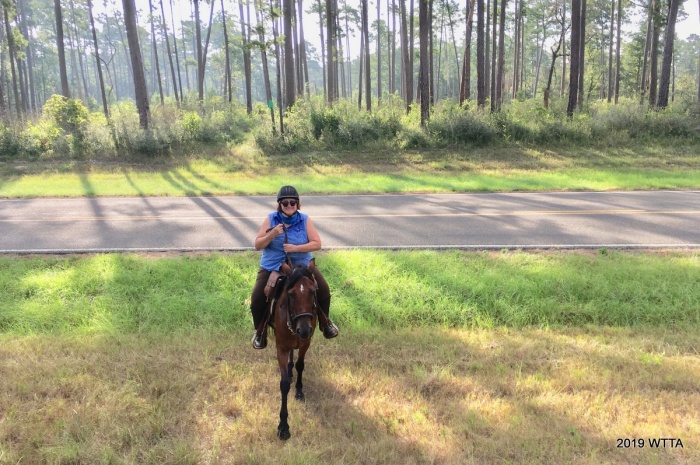
There are some road crossings along these trails such as FM 2781. Here Patti, aboard her BLM Dakota, showed us how it’s done. Of course look both ways and don’t dilly dally!
Trails are very well marked, and all road crossings are well signed. Different colored triangular markers indicate the route. Trails are easy with gently rolling terrain. It is also very shady, making it a great place for summer riding. There are no motorized vehicles allowed, to include, atv, utv, and dirt bikes, in the forest.
I have visited T Bar S twice now and was impressed both times. I did most of my riding in 2019 as unfortunately my horse was lame during my recent visit in Sept. 2021. Regardless, I still enjoyed hiking the trails with my canine companion, Eva. I also really enjoyed hanging out at the T Bar S campsite with my friends and critters.
This trail entry is a combination of information from my 2019 and 2021 visits, some information from friends, and information provided by the owners as well.
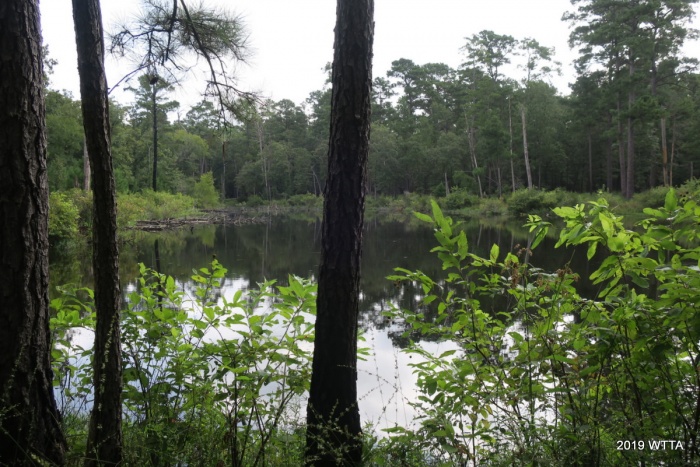
There are several watering opportunities along the trail.
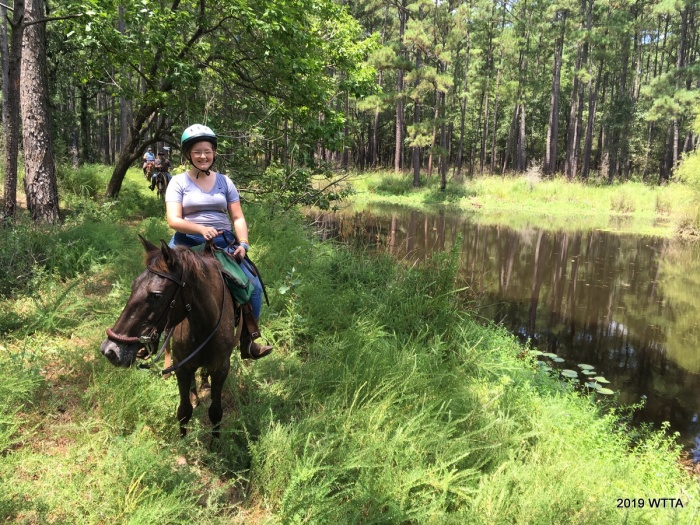
Another shady trail alongside a beautiful pond.
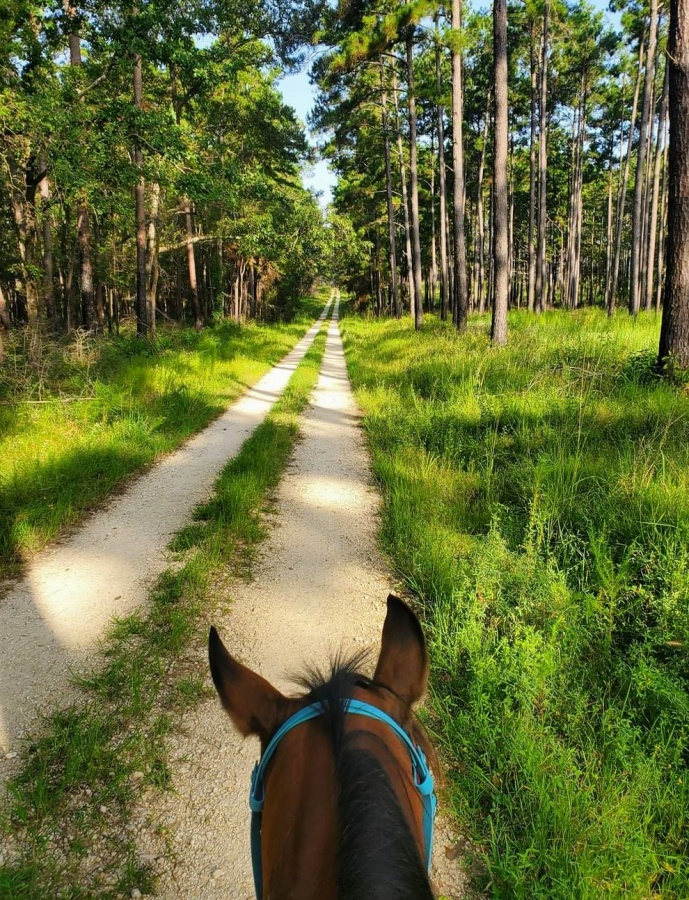
Most of the trails are soft sand with a few exceptions along some of the roads, such as in this picture provided by Trina Moya. She is enjoying the trails here for the first time and intends to return. – Sept. 2021.
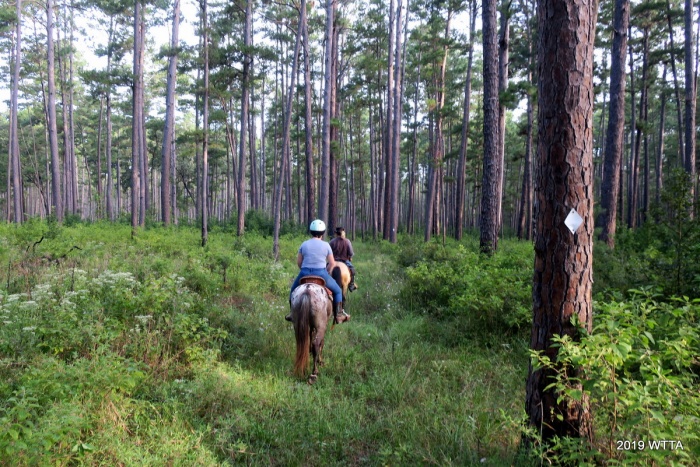
NETASA group enjoying 20 miles of the White trail. On this day we exceeded our plan by riding 22 miles!
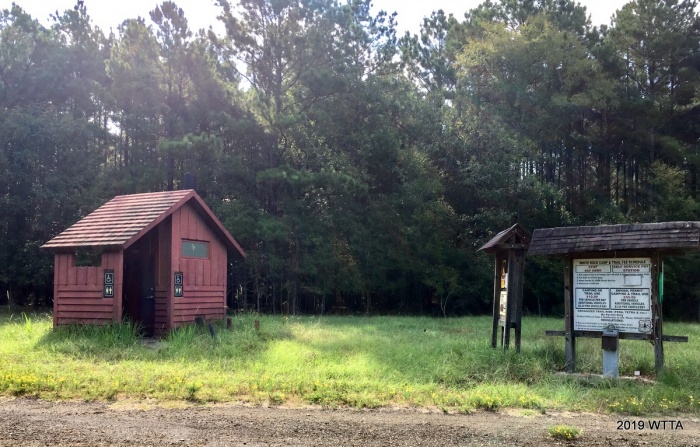
There are two trailheads: Piney Creek Trailhead has pit toilets, designated campsites, a self-service pay station and municipal water; White Rock Trailhead (pictured here) has pit toilets. Great to know for when you need to take a pit stop.
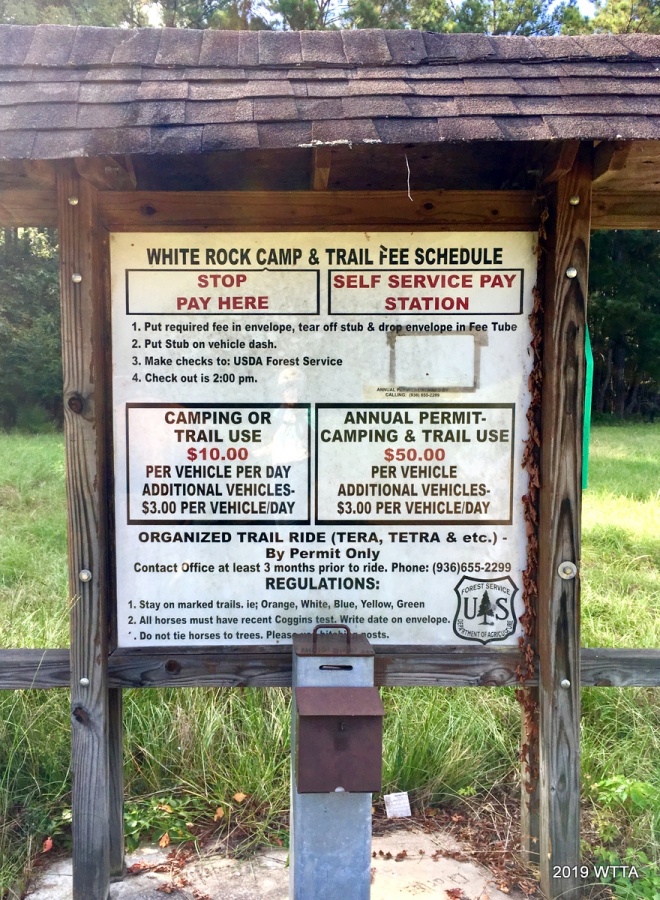
White Rock trail head.
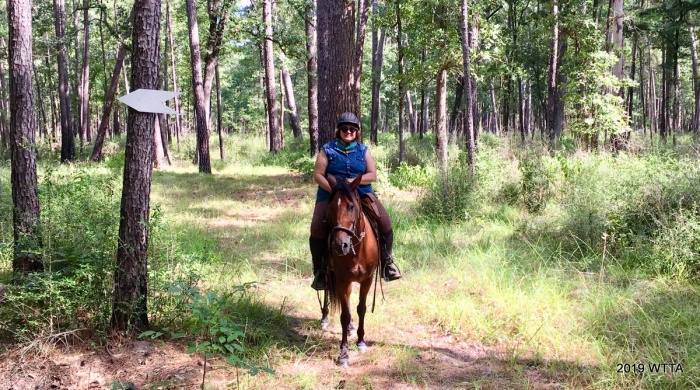
Patti and Dakota on the White Trail. This was their longest ride at 22 miles!
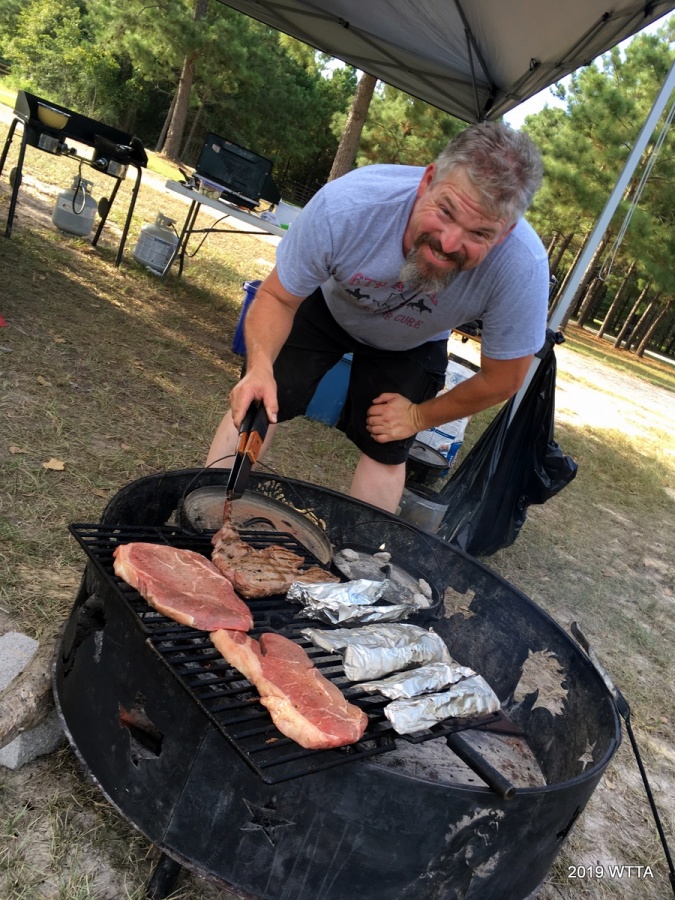
A great ride finished and back to the comfort of T Bar S. Look what Curtis has cooking for us!
